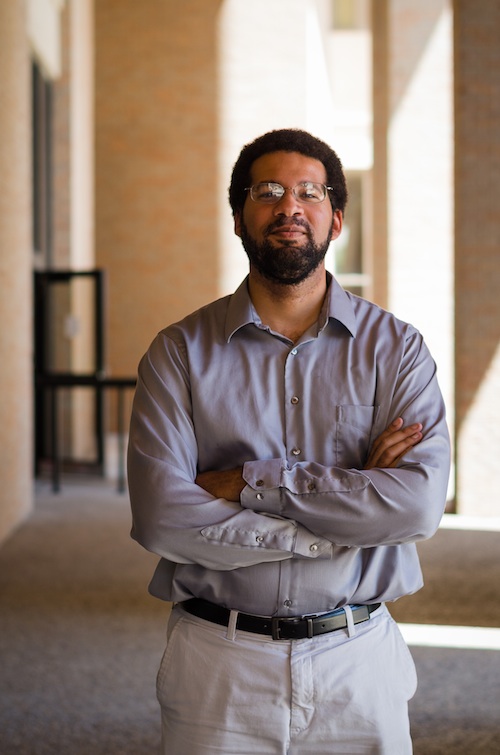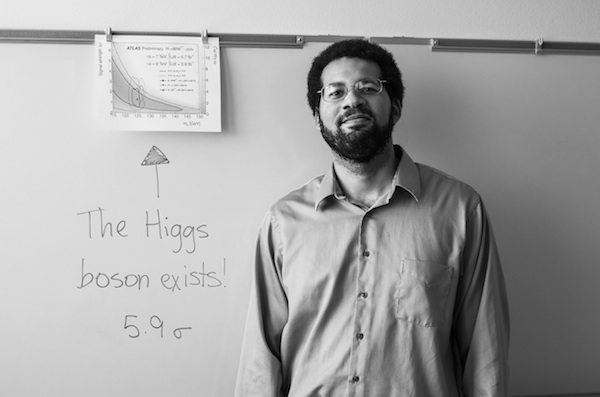New assistant professor Peter Onyisi was part of the team in Switzerland that confirmed the existence of the Higgs boson particle.

Physicist Peter Onyisi arrives as a new assistant professor in the College of Natural Sciences with an extraordinary feather already in his cap. He was part of the team at CERN working with the Large Hadron Collider that confirmed the existence of the Higgs boson particle.
I skyped with Onyisi back in July, when he was still in Switzerland. We talked about what it was like to be part of such a momentous discovery, why John Denver has a special place in his heart, and why he decided to come to Austin. He's now on campus, settling into his office in RLM. (Read about the college's 17 other new rock star faculty.)
Oppenheimer: What’s your origin story? When did the idea of becoming a physicist first manifest?
Onyisi: It started when I was a boy, growing up in Nigeria. We were able to get books from the British Council library, and one of the ones I took home was In Search of the Big Bang, by John Gribbin. It was a pretty well written popular science book that talked about the study of the early universe and particle physics and the idea that these two things are closely related. It actually talked about the Higgs boson.
In fact I remember reading about the Higgs boson with my Dad’s John Denver tapes on in the background. So “Rocky Mountain High” has this weird Higgs boson connection for me. That was the first moment I thought, “Wow, it would be really neat to learn about this sort of thing.” I didn’t say, “I want to find the Higgs boson someday,” but I thought it was a really neat thing to learn about. Then later I found out you could actually learn about it for a career.
When did you actually start looking for the Higgs boson?
I’ve been actively working in the group looking for the Higgs for about a year and a half.
How big is your group?
There were thousands of people on the overall project. The group that I was working in, doing one particular analysis, had 140 people, and there were 30 or 40 of us in that group who were on site, full time, at CERN, doing the day-to-day work.
What exactly were you looking for?
We were never going to be able look at something directly and say this is the Higgs boson. Rather, we had predictions about how the Higgs boson would interact with other particles, and what that interaction would produce.
If it existed as the theory predicted, it would be capable of decaying when it interacted with particles that were lighter than it, so what we were looking for were various things it could turn into in the end. We would see some electrons or some momentum imbalance in our experiment and that would indicate that this particular event, this particle collision, had produced something that looks like it came from the decay of a Higgs boson.
It’s a very statistical process. With any given collision you don’t know exactly what’s going to happen, but there is some probability that you’ll make a Higgs boson and that has some probability of decaying in a way you can detect. You’re really looking at traces of something that was there, and you have to accumulate a whole bunch of events in order to feel confident about your conclusion.
When did you realize you might have found it?
As early as late last year we had hints that something was going on. We noticed that we weren’t able to rule out the presence at a particular mass, and that was the first sign that there was something there, that we were unable to say it wasn’t there. Most of us tried to be cautious and make sure we were open to all possibilities, but I think we all suspected there was something there.
Was there one day when you saw something and were like, “That’s it!”?
Yes and no. The overall decision to announce that the Higgs boson had been found wasn’t based on one result. It took several different analyses all pointing toward the same conclusion. It was us saying we’ve seen it, and another group saying they’d seen it through a different analysis and someone else saying they’d seen it, to really reach the point where we were all convinced. So that was a cumulative thing, coming together over months.
But in terms of our particular analysis there actually was one climactic moment. There was a meeting where everyone scrutinized what we had done up to that point, where we had ruled out all the other interpretations and accounted for possible errors, and at that pointed we decided to go ahead and look at the most sensitive region to see if we saw anything. Then it was literally a couple of hours to run the code, and then at the end we saw the plot and we said, “There it is.”
Did you high five each other?
We didn’t exactly high five but we did break out the champagne. Well, to be perfectly honest someone was having a retirement party in the building. They had champagne to spare.
How long after that was the announcement made?
Most of the real evidence came in late May and June, and then it was decided that we would have a big reveal. We probably wouldn’t have scheduled it for July 4th, but it was right before a major conference, and a lot of the head people were going to be flying over, and we had to work around their schedules.
Exactly what we were going to say was in question until the last moment because we didn’t have all the pieces there. As the evidence became stronger and stronger as we approached the date, the exact tone changed. At first it was going to be an update, and then as it came closer to the moment it was decided to be more decisive.
 So is this a sure thing. I mean, you’ve definitely found it?
So is this a sure thing. I mean, you’ve definitely found it?
The Higgs boson means something very very specific, theoretically, in the standard model, so there are a bunch of equations that specify exactly what it means for something to be a standard model Higgs boson. We happen to live in a physical world where we can’t actually query the equations directly, but what we can do is see something that looks like what the equations predict. That’s what’s happened, but it’s still possible that it’s an approximation.
Think about how until the 20th century Newton’s equations were good approximations but turned out to be slightly wrong in certain limits and you had to go to special and general relativity to get a more refined model. It may be that the Higgs boson standard model is a good approximation but there is something beyond that.
That said, the fact that we have seen what we have seen now is a very strong constraint on what that something else could be. A lot of theories have now been thrown out, because they couldn’t possibly explain what we have seen. We have found something, and now we want to make sure we know what it is.
So what’s next? Are you ready to quit the Higgs boson?
At least in the medium term I am going to keep studying it. The experiment is going to shut down for a couple of years, so that they can do upgrades to the accelerator, and then it will come back in late 2014 and we will at that point have more ways to study the Higgs boson. We’ll also have a better shot at producing other kinds of new particles.
One of the things that is very interesting about the Higgs boson is that learning about how it decays gives you very interesting information about what kinds of other new particles you can look for. The fact that we have seen it where it is, and that it has the properties that we have seen, puts extremely strong constraints on what else could be there. It makes certain things more likely than others.
The Large Hadron Collider is really a discovery machine. We have the ability to suddenly find things that no on ever expected, and because of that we don’t know how we are going to push our way through the things we do find. The plan is to keep doing physics and see where that takes us.
Last question: Why UT? You must have had other offers?
I was really impressed by the faculty. I enjoyed meeting Steven Weinberg, who is one of the people responsible for starting us down this road of finding the Higgs boson in the first place. The city is great.
When I came for my interview I had never been to Austin before, and I had no idea what to expect. But I came here and said, okay, this is basically my dream job.

















Comments 2
How does it look from the Einstein theory of general relativity?
Great feat there brother, keep it up. forget not home